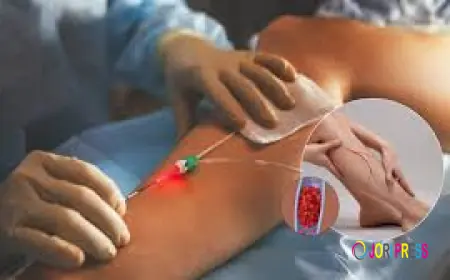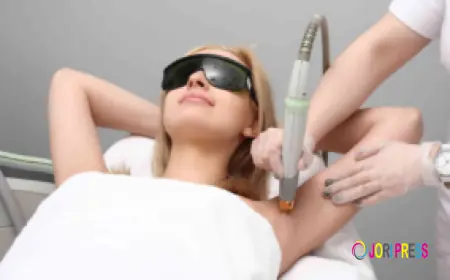What to Expect from Facelift Surgery? Your Guide to Rejuvenation in Riyadh
A well-executed Face Lift in Riyadh directly targets these changes, offering a comprehensive solution that can rewind the clock on your appearance, delivering results that are both dramatic and natural-looking.

As we gracefully navigate through life, our faces tell a story – a story of smiles, laughter, and perhaps, the passage of time. While every wrinkle holds a memory, many individuals desire to refresh their appearance, seeking a more youthful and vibrant reflection in the mirror. Facelift surgery, technically known as rhytidectomy, is a powerful cosmetic procedure designed to address visible signs of aging in the face and neck. It goes beyond surface-level treatments, meticulously lifting and tightening underlying tissues, removing excess skin, and redraping the remaining skin to create a smoother, firmer, and more rejuvenated contour. For those considering a transformative journey in Riyadh, understanding what to expect from facelift surgery is the essential first step towards achieving their aesthetic goals.
The Science of Facial Aging
Facial aging is a complex process involving multiple layers: skin, fat, muscle, and bone. Over time, collagen and elastin (proteins responsible for skin elasticity) diminish, leading to sagging skin. Fat pads in the face can descend or deplete, contributing to a hollowed or sunken appearance. Muscles weaken, and gravity takes its toll, resulting in jowls, deep folds around the nose and mouth (nasolabial folds), and a "turkey neck." A well-executed Face Lift in Riyadh (جراحة شد الوجه في الرياض) directly targets these changes, offering a comprehensive solution that can rewind the clock on your appearance, delivering results that are both dramatic and natural-looking.
Beyond the "Tight" Look: A Natural Rejuvenation
Modern facelift techniques prioritize a natural, refreshed appearance over a "pulled" or overly tight look. The goal is to restore youthful contours and proportions, not to erase every wrinkle entirely. By repositioning underlying structures, a skilled surgeon aims to create a harmonious balance that revitalizes your face while maintaining your unique expressions and identity. This focus on natural results is a key characteristic of advanced Face Lift in Riyadh procedures.
Candidacy for a Face Lift in Riyadh, Jeddah and Saudi Arabia: Are You a Good Candidate?
Deciding to undergo Face Lift in Riyadh, Jeddah and Saudi Arabia is a significant personal choice that requires careful consideration. Not everyone is an ideal candidate for this procedure, and a thorough evaluation by a qualified professional is essential to determine suitability and set realistic expectations.
Signs of Facial Aging
The primary reason individuals seek a facelift is to address specific signs of aging in the face and neck.
-
Sagging Mid-Face: A loss of youthful fullness in the cheeks and a descent of facial fat pads can lead to a tired appearance.
-
Deep Creases Below the Lower Eyelids: While a facelift primarily targets the lower two-thirds of the face, it can indirectly improve the appearance of the mid-face.
-
Deep Creases Along the Nose to the Corner of the Mouth (Nasolabial Folds): These prominent lines can be softened.
-
Jowls: Loose skin and fat along the jawline creating a heavy, sagging appearance.
-
Loose Skin and Excess Fat Under the Chin and Neck ("Turkey Neck"): Often addressed in conjunction with a facelift for a harmonious result.
It's important to note that a facelift doesn't address fine lines around the eyes (crow's feet), forehead wrinkles, or skin quality issues like sun damage or uneven pigmentation. These often require complementary procedures such as eyelid surgery (blepharoplasty), brow lifts, or laser skin resurfacing.
Good General Health
As with any surgical procedure, overall health is a critical factor.
-
No Major Medical Conditions: Candidates should be in good general health with no life-threatening medical conditions or chronic illnesses that could impair healing or increase surgical risks.
-
Well-Controlled Existing Conditions: If you have conditions like high blood pressure or diabetes, they must be well-controlled.
-
Non-Smoker: Smoking significantly compromises circulation and wound healing, increasing the risk of complications. Candidates are typically required to stop smoking several weeks or months before surgery and abstain throughout the recovery period.
Realistic Expectations and Positive Outlook
A successful facelift journey begins with a clear understanding of what the surgery can and cannot achieve.
-
Improvement, Not Perfection: A facelift can significantly rejuvenate your appearance, but it will not stop the aging process entirely or create a completely different look.
-
Emotional Stability: Patients should be emotionally stable and undergoing the procedure for personal reasons, not due to external pressure.
-
Willingness to Follow Instructions: Adhering to pre- and post-operative instructions is crucial for optimal results and safe recovery.
Adequate Skin Elasticity and Strong Bone Structure
These physical characteristics contribute to the quality and longevity of facelift results.
-
Skin Elasticity: While sagging skin is addressed, a certain degree of skin elasticity is beneficial for smooth redraping and natural-looking contours.
-
Bone Structure: A well-defined bone structure provides a good foundation for the lifted tissues, contributing to more aesthetically pleasing and lasting outcomes.
During your initial consultation in Riyadh, a thorough evaluation of these factors will be conducted to determine if a Face Lift in Riyadh, Jeddah and Saudi Arabia is the most suitable and safe option for your unique needs and aesthetic aspirations.
The Facelift Procedure: What Happens During Surgery
Understanding the surgical process can help alleviate anxiety and prepare you for your transformative journey. A facelift is a highly individualized procedure, but generally involves several key steps designed to rejuvenate your appearance.
Anesthesia
Your comfort and safety are paramount throughout the procedure.
-
General Anesthesia: Most facelift surgeries are performed under general anesthesia, meaning you will be completely asleep during the operation.
-
Local Anesthesia with Sedation: In some cases, or for less extensive procedures (like a mini-facelift), local anesthesia combined with intravenous sedation may be used, allowing you to remain awake but deeply relaxed and comfortable. The choice of anesthesia will be discussed with you during your consultation.
Incision Placement
The placement of incisions is strategically planned to be as inconspicuous as possible.
-
Traditional Facelift: Incisions typically begin in the hairline at the temples, extend down in a natural crease in front of the ear, around the earlobe, and then behind the ear into the lower scalp.
-
Limited Incision Facelift (Mini-Facelift): Shorter incisions are made, usually limited to the hairline around the temple and around the ear, without extending into the lower scalp. This is suitable for patients with less extensive aging.
-
Neck Lift Incision: If a neck lift is performed concurrently, an additional small incision may be made under the chin to address platysmal (neck muscle) banding and excess fat.
-
Scar Minimization: Surgeons meticulously plan incisions to blend into natural creases and the hairline, ensuring scars are discreet once healed.
Lifting and Repositioning of Underlying Tissues (SMAS)
This is the core of a modern facelift, addressing the deeper layers of the face.
-
Skin Elevation: The skin is carefully separated from the underlying tissues.
-
SMAS Manipulation: The Superficial Musculoaponeurotic System (SMAS), a layer of muscle and connective tissue beneath the skin, is tightened, lifted, and repositioned. This is crucial for creating natural and long-lasting results, as it addresses the underlying cause of sagging.
-
Fat Repositioning/Removal: Fat may be sculpted, removed, or redistributed to restore youthful contours and volume. Sometimes, fat grafting (transferring fat from another part of your body) may be used to restore volume in hollowed areas.
Redraping and Trimming of Skin
Once the underlying structures are repositioned, the skin is carefully redraped.
-
Gentle Redraping: The facial skin is gently pulled back and upwards over the newly contoured underlying tissues.
-
Excess Skin Removal: Any excess skin that results from the lift is carefully trimmed away.
-
Suture Closure: The incisions are then meticulously closed with sutures or skin adhesives, often absorbable ones.
Dressings and Drains
At the end of the procedure, dressings are applied to aid in healing.
-
Bandages: Your face and neck will likely be loosely bandaged to minimize swelling and bruising and to provide gentle compression.
-
Drains (Optional): Small, thin tubes called drains may be placed temporarily under the skin behind your ears to collect any excess blood or fluid. These are typically removed within a day or two.
A Face Lift in Riyadh is a complex procedure that typically takes several hours to complete, depending on the extent of the lift and whether it's combined with other procedures. Your surgical team will ensure your comfort and safety throughout.
The Facelift Recovery Journey: What to Anticipate After Surgery
Understanding the recovery process is crucial for a smooth and successful outcome after Face Lift in Riyadh. While individual healing times vary, there are common phases and expectations.
Immediate Post-Operative Period (First Few Days)
The first 24-72 hours are crucial for initial healing and managing discomfort.
-
Bandages and Drains: You will wake up with bandages around your face and possibly drains. These help reduce swelling and bruising. The drains are usually removed within 1-2 days, and bandages often within a week.
-
Swelling and Bruising: Expect significant swelling and bruising, which will likely peak around days 3-4. This is a normal part of the healing process. Cold compresses can help manage this.
-
Discomfort: You will experience some discomfort, tightness, and numbness in the treated areas. Pain medication prescribed by your surgical team will help manage any pain.
-
Rest and Elevation: It is vital to rest with your head elevated (even while sleeping) to help reduce swelling. Avoid bending over, straining, or any strenuous activity.
Early Recovery (First 2-4 Weeks)
During this phase, visible signs of surgery begin to subside, and you'll gradually feel more like yourself.
-
Bruising and Swelling Fading: Bruising will start to fade and change color, while swelling will gradually diminish.
-
Suture Removal: Non-dissolvable sutures, if used, are typically removed around 7-10 days after surgery.
-
Return to Light Activities: Most patients can return to light, non-strenuous work or daily routines after 2-3 weeks, depending on the extent of the surgery and your personal healing rate. Avoid heavy lifting or strenuous exercise.
-
Sensations: Numbness, tightness, tingling, or itching are common sensations as nerves regenerate. These usually improve over weeks to months.
Mid-Recovery (Months 2-3)
Significant improvements continue, and you'll start to see the more refined results.
-
Swelling Resolution: Most of the major swelling will have resolved, revealing more defined facial contours.
-
Scar Maturation: Incisions will start to flatten and fade, though full scar maturation takes several months to a year or more. Protecting scars from sun exposure is critical.
-
Increased Activity: You'll be able to resume most normal activities, including more vigorous exercise, as cleared by your surgical team.
Long-Term Results (6 Months to 1 Year and Beyond)
The final results of your Face Lift in Riyadh will fully emerge, and you'll enjoy a rejuvenated appearance.
-
Final Contours: Any residual swelling will be gone, and your facial contours will have settled into their final, natural-looking positions.
-
Scar Fading: Scars will continue to soften and become less noticeable.
-
Longevity: While a facelift cannot stop the aging process, its results are long-lasting, often providing a more youthful appearance for 10-15 years or more. Maintaining a healthy lifestyle and good skincare practices can help prolong your results.
Your surgical team will provide detailed post-operative instructions and schedule follow-up appointments to monitor your healing and ensure optimal results throughout your recovery from your Face Lift in Riyadh.
Frequently Asked Questions
Considering facelift surgery often brings many questions to mind. Here are uniquely highlighted answers to some frequently asked questions, particularly for those in Riyadh.
Many People Wonder: How long do the results of a Face Lift in Riyadh typically last?
The results of a Face Lift in Riyadh are long-lasting, but it's important to understand that the surgery doesn't stop the aging process entirely. Generally, patients can expect their rejuvenated appearance to last 10 to 15 years or even longer. The longevity of results depends on various factors, including the type of facelift performed, individual aging patterns, genetics, lifestyle habits (like sun exposure and smoking), and diligent skincare. While gravity and time will continue to have an effect, a facelift essentially "resets the clock," making you look significantly younger than you would have without the procedure.
Is it true that: A Face Lift in Riyadh will eliminate all my wrinkles?
No, a Face Lift in Riyadh will not eliminate all your wrinkles. The primary goal of a facelift is to address sagging skin, deep folds (like nasolabial folds and marionette lines), jowls, and loose neck skin by lifting and tightening the underlying facial muscles and tissues. While it significantly smooths and rejuvenates the lower two-thirds of the face, it typically does not address fine lines and wrinkles around the eyes (crow's feet) or on the forehead. For these areas, complementary procedures like Botox, dermal fillers, laser resurfacing, or eyelid/brow lift surgery are often recommended to achieve a comprehensive facial rejuvenation.
Often Asked: What are the main differences between a mini facelift and a traditional Face Lift in Riyadh?
The main differences between a mini facelift and a traditional Face Lift in Riyadh lie in their scope, incision length, and the extent of correction. A mini facelift uses shorter incisions, usually around the ears, and primarily addresses mild to moderate sagging in the lower face and jawline. It's less invasive with a quicker recovery, suitable for younger patients or those with early signs of aging. A traditional facelift involves more extensive incisions (extending into the hairline and behind the ears) and comprehensively addresses significant sagging in the mid-face, jowls, and neck. It provides more dramatic and longer-lasting results, making it suitable for more advanced signs of aging.
Frequently Inquired: Can I combine a Face Lift in Riyadh with other cosmetic procedures?
Yes, it is very common and often beneficial to combine a Face Lift in Riyadh with other cosmetic procedures to achieve a more harmonious and comprehensive facial rejuvenation. Popular complementary procedures include: Eyelid surgery (Blepharoplasty) to address sagging eyelids and under-eye bags; Brow lift to correct a drooping brow and forehead wrinkles; Neck lift (often performed as part of a facelift but can be separate if the primary concern is the neck); and Fat grafting or dermal fillers to restore lost volume in certain areas of the face. Your surgeon will discuss which combination of procedures would best suit your aesthetic goals during your consultation.
Your Rejuvenation Journey Awaits in Riyadh
Facelift surgery offers a profound opportunity to refresh and revitalize your appearance, helping you regain the confidence that comes with a more youthful reflection. By understanding the intricate details of the procedure, managing your expectations, and committing to the recovery process, you can embark on this transformative journey with confidence in Riyadh.
Ready to discuss your aesthetic goals and explore the possibilities of a Facelift? Contact Royal Clinic Saudia in Riyadh today for a personalized consultation with their expert surgical team.
What's Your Reaction?
 Like
0
Like
0
 Dislike
0
Dislike
0
 Love
0
Love
0
 Funny
0
Funny
0
 Angry
0
Angry
0
 Sad
0
Sad
0
 Wow
0
Wow
0

















































